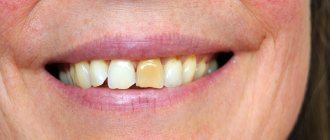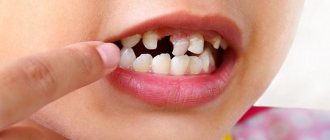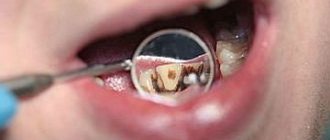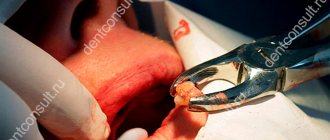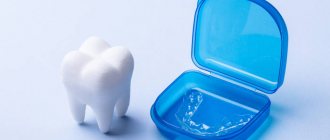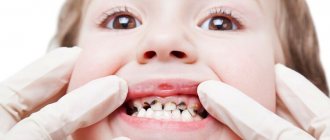Why do teeth turn yellow?
Do you want to have a snow-white smile, but your teeth are not particularly white? In most cases, this is not a reason to be upset. Remember, perhaps your teeth have always been like this and this is your innate dentin color. Sometimes this indicates a large amount of minerals in the tooth tissue. If the enamel begins to turn yellow
gradually and this happens almost before your eyes, let's figure out
why teeth turn yellow
and look for a solution to the problem.
Why is this happening?
Tetracycline teeth can occur for only two reasons. Most often, the process of pathological changes in enamel occurs in the womb. This is possible if the expectant mother was prescribed tetracycline-based drugs for some reason. Dentists note that even a short course of treatment (2-3 days) can provoke this disease.
The second reason is taking medication during the eruption of permanent teeth, which usually occurs at 7-9 years of age. The teeth themselves will not become snow-white again if no measures are taken. Even in adulthood, the units will still remain dark with uneven coloration.
Why do children's teeth turn yellow?
Basically, dentists are of the opinion that this happens due to improper oral care. If you don’t brush your teeth, or don’t do it often enough, then soft plaque can ruin your baby’s smile, so you should carefully monitor how your child follows the dentist’s instructions, whether he holds the brush correctly, and follows the sequence of manipulations.
If you are undecided why your teeth turn yellow, what should you do? The answer is obvious - go to the dentist! If you have yellow spots or only a tooth has changed color, this may indicate injury to the pulp or the presence of a root infection - in both cases, treatment is urgent, otherwise you may not only lose a tooth, but also get serious problems and complications.
Stages and signs
This pathology can be recognized by the following symptoms:
- The presence of obvious transverse stripes on the enamel.
- Teeth become brown or yellow.
- Sometimes increased sensitivity of units develops.
Depending on the severity, symptoms may vary slightly:
- A mild degree is characterized by a uniform darkening of 1-2 tones. Many people don’t even realize that this color is caused by an antibiotic.
- Medium degree – pronounced yellow color of teeth with transverse stripes. In this case, you can correct the situation with professional dental procedures.
- The third stage - the teeth have become dark brown, and closer to the gum the color is darker than at the top. In this case, only dental restoration will help.
How to whiten your teeth.
If you want to whiten your teeth to the natural color of dentin, then, at a minimum, special whitening pastes with abrasives will help. The most reliable remedy is professional teeth cleaning in the dentist's office.
If you want your naturally yellowish teeth to become white, then the heavy dental artillery comes into play. Photo whitening, laser method, zoom and others. Any of the methods, by the way, are extremely harmful to the teeth, and are not cheap. So think carefully. The second time the teeth will not grow, neither yellow nor white.
Treatment options
How to make your smile graceful and your teeth white? There are several methods of dental treatment, but the technique is determined individually depending on the severity of the pathological process. Please note that it is impossible to cope with the task at home. You should not experiment and test different whitening products. This way you can only worsen the condition of the enamel. Trust the professionals; dentists will choose the best way to solve your problem.
Let's consider the most effective methods:
- Ultrasonic cleaning. Professional cleaning is carried out regardless of the severity of the disease. The doctor removes hard deposits and cleans plaque on teeth even in the most inaccessible places.
- Remineralization. The goal of therapy is to saturate the dental tissue with fluoride and calcium. This is done using special lotions on the enamel or through phonophoresis. This technique allows you to cope with mild to moderate tetracycline teeth.
- Fluoride varnish. This stage follows remineralization. The enamel is coated with a special compound that forms an invisible film to protect against external factors. It also helps to cope with increased sensitivity and strengthen the enamel.
- Bleaching. This is only effective if there is a slight degree of staining and the color of the teeth is uniform. In other cases, whitening does not work on tetracycline teeth.
- Dental restoration. This is relevant if all of the above methods did not have positive dynamics. Depending on your financial situation, the doctor will suggest composite restoration, installation of crowns, veneers or lumineers.
Today, tetracycline-based antibacterial drugs are practically not used. They are replaced with similar drugs that do not affect the teeth.
Naturally yellow teeth are an indicator of a healthy body.
In truth, tooth enamel is almost completely transparent. A slight shade of yellow color is added to it by minerals, which strengthen its structures and give teeth strength. Dentin is the element underneath the enamel that sets the tone for a smile. By nature, dentin is not endowed with a white tint, because it also contains minerals. And the natural yellow tint of tooth enamel can indicate that:
- A person has healthy teeth, with which there will be no problems for a long time due to their high mineralization, which resists the occurrence of caries;
- Enamel is endowed with a large number of minerals, and therefore is strong and becomes an excellent protection for teeth. But absolutely white teeth that have a slight dullness can indicate that there are not enough minerals in the enamel. And this increases the risk of tooth sensitivity and the development of caries;
- Teeth have an individual structure, and this completely eliminates the similarity of their shades. And due to this, those who monitor their oral health often have a question: why do fangs have a more yellow tint than other teeth? And all because fangs are stronger teeth, which contain the largest proportion of dentin, which is responsible for the characteristic color.
Therefore, if a person has naturally yellow teeth, he can be sure that they are completely healthy. But, if a more intense plaque appears that was not previously noticed, this is a reason to make an appointment with a specialist.
Reasons influencing the occurrence of yellow plaque on enamel
When assessing the condition of the patients’ oral cavity, dentists formulated the following main circumstances that caused the appearance of yellowness on tooth enamel:
- Smoking;
- Foods that contain high levels of sugar, which in turn have a positive effect on increasing the number of bacteria. The products of their metabolism have a detrimental effect on the enamel, the top layer of which begins to thin out and acquire a transparent color;
- Regular consumption of drinks that contain persistent food dyes;
- Age can also become an inevitable factor due to which yellowness may form on the enamel;
- Heredity.
If even just one tooth turns yellow, you should definitely consult a specialist, because this can be a symptom of a very complex disease in the field of dentistry. Without an examination procedure, it is impossible to determine the exact cause of darkening of the teeth. Caries and poor quality crowns can cause similar results.
Smoking
There are substances in cigarette smoke that tend to accumulate and contribute to the darkening of teeth. To prevent this reason from becoming an indicator of an unaesthetic smile, a special toothpaste was created for smokers, but it is not an effective remedy, but professional whitening can easily restore an attractive appearance to teeth.
Food colorings
Coca-Cola, coffee, tea and many other drinks that contain rich dyes stain tooth enamel. The substances in these drinks tend to get into the pores of the enamel and leave a dark tint in them. With constant consumption of these drinks, tooth enamel will have a brown tint.
Sugar
Teeth begin to darken quite quickly if you often eat foods containing a lot of sugar. The oral cavity is saturated with a variety of bacteria that destroy active carbohydrates from food and form acid. This acid tends to have a negative effect on tooth enamel, corroding it and thinning it.
Age
Aging also takes its toll on teeth. Even if a person does not have bad habits and does not drink drinks with persistent dyes, over the years the enamel may become thinner and turn yellow.
Poor oral care
Poor oral hygiene can contribute to the appearance of a yellow tint on teeth. Factors for this phenomenon can be a reduction in the amount of daily dental care, replacing the toothbrush with chewing gum, unsuitable toothpaste, etc.
Heredity
Heredity can also significantly affect the shade of teeth. For example, if the father and mother of the baby have a yellow tint to their teeth, then the likelihood that the child will also have enamel of a similar color is quite high.
Why do children's teeth turn yellow?
There are cases when a child’s yellow teeth immediately come out. Most likely, this color is hereditary, so there is no need to worry, but it would not be a bad idea to contact a specialist with this question. You need to know that there are quite serious factors that affect the yellowing of a child’s teeth, but this danger threatens only older children.
The most common reason for the appearance of yellow plaque on the teeth of children is neglect or insufficient attention paid to cleaning the oral cavity.
Teeth whitening
Thanks to innovations in modern dentistry, people have access to teeth whitening with varying levels of complexity. This procedure will not cause pain in the patient and will go away quickly enough.
Therefore, there is no need to despair if, by nature or for certain reasons, your teeth have a yellow tint - this problem can be corrected.
Why does black plaque appear on teeth?
Black plaque on children's teeth can have a variety of causes:
- Hereditary predisposition.
- The result of the vital activity of certain microorganisms. This kind of plaque appears when there is dysbacteriosis, disturbances in the functioning of the digestive system when the child is switched to a different diet or new products are included in the children's menu.
- Lack of calcium during fetal development, as well as in the postnatal period.
- Taking iron supplements or certain antibiotics.
- Malfunctions of the immune system.
- Insufficient hygiene or incorrect choice of hygiene products.
- Caries and enamel hypoplasia.
- Dysfunction of the salivary glands.
It also happens that a completely healthy one-year-old child develops black plaque on his teeth literally out of nowhere. In such cases, most likely, we are talking about Priestley’s plaque, the reasons for which have not yet been established with reliable accuracy.
Antibiotics: from myth to drugs of the 21st century
There are many myths surrounding antibiotics.
To be ready for further conversation, you and I need to immediately deal with the most important things. There are only three of them.
ANTIBIOTICS CAUSE DYSBACTERIOSIS
Not really. It is extremely difficult to achieve intestinal decontamination, that is, a condition in which antibiotics kill ALL flora in the intestines and anyone can live there.
To do this, antibiotics will have to be taken for months and in fairly large dosages.
In cases where a child falls ill with an acute respiratory infection, such regimens are never prescribed by doctors.
ANTIBIOTICS SUPPRESS THE IMMUNE SYSTEM
Not really.
The immune system is formed according to the principle of clonal selection: in response to each contact with an infection, a special clone of cells is created in the immune system - “specialists” for this particular infection. Doctors call them memory cells.
When the same infection is re-infected, memory cells begin to multiply instantly and suppress this infection quickly - often faster than it can manifest itself.
By the way, this is how vaccinations work—they create clones of memory cells in response to the introduction of killed, dismembered, or even fake infections.
To create memory cells, contact with an infectious agent is sufficient; a full-blown disease is not required at all.
WITH THE FREQUENT USE OF ANTIBIOTICS, A FLORA IS FORMED THAT CANNOT BE KILLED BY ANYTHING
But this is partly true. Indeed, some infectious agents, such as pneumococcus or Staphylococcus aureus, as a result of prolonged exposure to antibiotics, become resistant to almost any antibacterial drug known to mankind.
Such pathogens can be found in surgical hospitals - especially those that have been operating for decades, and doctors, faced with an infection that is not immediately treatable, always ask the patient if he has been treated in such a hospital for a long time.
Why are they asking this question? Yes, because there is simply nowhere else to get such a microorganism that is resistant to everything. It is physically impossible to grow something like this at home, gradually poisoning some infection with pharmaceutical antibiotics. Life is not enough.
What is important to know about antibiotics
Doctors say the effect of antibiotics on teeth cannot be underestimated. On the one hand, they destroy harmful bacteria, stop the growth of pathogenic flora, and prevent the development of complications, in particular, infectious and inflammatory processes.
In the same dentistry, they are often prescribed after complex tooth extraction, implantation and other surgical procedures. In complex therapy for the treatment of periodontitis, gumboil, cysts, odontogenic osteomyelitis, periodontitis, periodontal disease, alveolitis. They are also prescribed as a supportive and preventative[1] measure for patients with chronic diseases. For example, diabetes mellitus and cardiovascular pathologies. For what? To avoid complications during and after dental procedures, to ensure good and rapid tissue healing.
To whom are they dangerous?
On the other hand, many drugs do not have a selective effect. Many of them destroy not only harmful, but also beneficial microflora, and also lead to a number of negative consequences, which we will discuss further.
However, the most complete negative properties of such drugs can manifest themselves in the following groups of patients:
- for those who take medications without a doctor’s prescription,
- in pregnant women, young children and the elderly,
- for multiple dental problems,
- if you have chronic diseases and weakened immunity,
- if there are contraindications to a specific group of antibiotics,
- if the instructions for use are violated: do not increase the dosage, reduce or extend the course of antibiotic therapy. It is forbidden to take medications together with alcohol,
- with long-term antibiotic therapy as prescribed by a doctor.
How to get rid of black plaque on teeth?
Whether in this case treatment of baby teeth is necessary or only proper hygiene can be done, only a specialist can decide. Therefore, if black plaque appears between the teeth or on the inside of the teeth (the most common places of localization), you should contact your dentist as soon as possible. He will determine the cause of darkening of the enamel and recommend how to remove black plaque from teeth in the most effective way.
In case of caries or non-carious lesions of the enamel, appropriate therapy will be required, but if we are talking about dysbiosis, it will need to be treated first. In addition, it will be necessary to normalize oral hygiene using care products recommended by the doctor and the child’s diet. You will also need to have your teeth cleaned by a dentist, since cleaning your teeth from black plaque at home is often problematic and can be dangerous for your gums. It should be remembered that blackening after cleaning may appear again if hygiene is not maintained and the child’s diet and drinking regime are not adjusted.
Parents need to remember that this condition can lead in the future to the development of a number of inflammatory and infectious diseases of the oral cavity, so it should not be ignored. The best solution when identifying a problem would be to immediately search for a good pediatric dentist and additional consultation with a pediatrician if there is a possibility that the cause is endocrine or other disorders in the body.
“32 Dent” dentists employ professionals in their field. Dental treatment and prosthetics for both adults and children are carried out at the highest level. Modern equipment, direct supplies of materials from manufacturers and our own dental laboratory ensure high quality and affordable prices.
The effect of drugs on children's teeth
It is important for everyone who has children to know about the effect of antibiotics on baby teeth. Without reason, doctors try not to prescribe strong drugs such as antibiotics to children and pregnant women. Because in this case they can lead to the development of more serious consequences than just a change in the color of the enamel.
Some types of drugs, such as tetracycline, affect tissue structure. Especially during the period of active formation and mineralization of bone structures, that is, when the fetus is still in the mother’s body or when the child is not yet 2-3 years old. As a result, because of this, the milk and permanent elements of the series, as a rule, have anomalies in eruption, growth and development. Most often, children experience the following pathologies: yellow “tetracycline” teeth, hypoplasia (underdevelopment of enamel), multiple caries, and malocclusion.
It is important to remember that children have characteristics that distinguish them from adults. Thus, children's saliva contains few protective enzymes, and general and local immunity is rather weak. The enamel is thin and insufficiently mineralized. Without adult supervision, children brush their teeth very poorly. Together with taking antibiotics that destroy beneficial bacteria, all these factors lead to an increased risk of developing caries and pulpitis, various forms of stomatitis, damage to baby teeth, as well as the rudiments of permanent units.
Interesting! Today, more modern drugs have appeared that are excellent substitutes for tetracycline. Therefore, there are fewer and fewer people who suffer from such a pathology as “tetracycline” teeth. These are mainly patients over 35-40 years old.
What to do with yellow teeth
Thus, we counted plenty of factors. The question remains - what to do about it? Today, technology makes it possible to solve the problem of yellow teeth quickly, painlessly and effectively. At Dentik we use the innovative ZOOM Advanced Power whitening system. It allows, using calcium phosphate and exposure to a safe diode lamp, to lighten teeth by several tones, without harming their health and guaranteeing a long-term effect. The specialist will also advise you on how to properly care for your whitened teeth and give you a set of home care products.
Contact our clinic and take advantage of this great opportunity! A dazzling smile is simple and safe!


